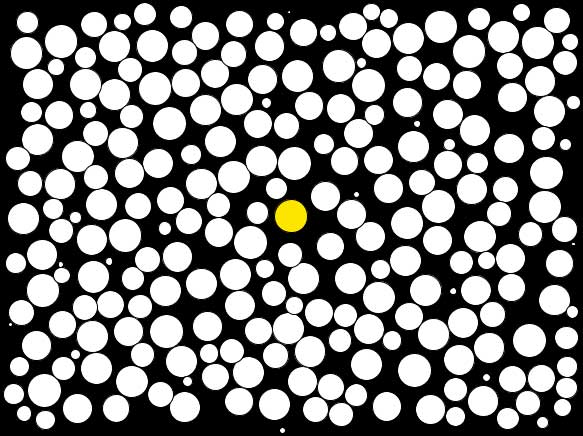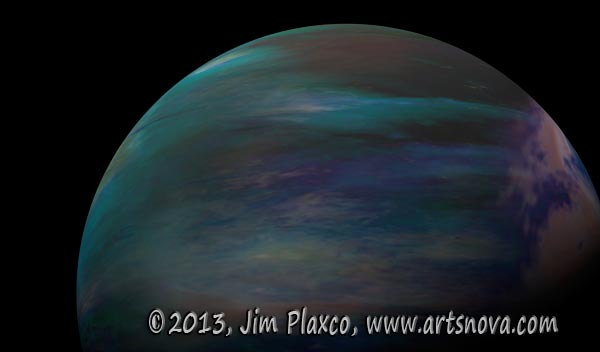The Small Stars of Exoplanets

Exoplanet Stars As Large As Or Smaller Than Our Sun (Yellow in center of image)
Last month I decided to do a series of paintings of exoplanets. It's been a while since I've done any astronomical art and little of what I've done is actually on my web site. A series on exoplanets appealed to me. The complexity of my exoplanet art project has greatly increased since that initial idea.
First I wanted to only paint actual confirmed exoplanets – which meant doing research on specific exoplanets. Fortunately a treasure trove of data is available online. I next began painting some exoplanets. It then occurred to me that it would be worthwhile to paint a number of these exoplanets with the planet's central star in the field of view. The downside of this approach is that geometry dictates that much of the planet would be in darkness from the observer's point of view. Still, I decided to proceed. To do this accurately meant that I'd need even more information. Information on the star's spectral type is needed to accurately represent the star's color. Information on the planet's orbital radius and the star's radius is needed to accurately size the star in the painting. This is even more crucial for planets in binary star systems.
Fortunately the necessary information is widely and freely available. Not only are there multiple star catalogs, there are also multiple exoplanet catalogs from which all the basic data can be obtained. The next step was to integrate the data from the separate catalogs and produce my own unified star/exoplanet database limited to confirmed exoplanets. This integration is still a work in progress.
You will note that I have emphasized confirmed exoplanets. This is because there is a far larger number of exoplanet candidates – a few thousand in fact. A number of these have been found by NASA's Kepler spacecraft, whose mission is to search our Milky Way galaxy for Earth-sized planets in or near their star's habitable zone
As part of my piecemeal development approach, I exported some of the star data into a csv file. I then wrote a Processing program that would parse the file, create an array of star objects, and do some basic analysis. To test several of the routines, I had the program output some very basic information about the stars:
- Record count = 910 (note: I did not remove duplicate entries for this run)
- The most massive star is HD 13189 with a mass 4.5 times greater than the Sun
- The hottest star is NY Vir with an effective temperature of 33,000.0 Kelvin
- The largest star is HD 208527 with a radius 51.1 times greater than the Sun's
- The smallest star is 2M 0746+20 with a radius 0.089 times the Sun's
Out of curiosity, I decided to create a routine that would draw all these stars to the same scale. The first and hardest step was to figure out how to automatically draw them – I certainly wasn't about to manually place them. I developed a modified circle packing algorithm to place the stars on screen without overlapping. Unfortunately given the number of stars and the range of sizes (0.09 to 51 times Sol's radius) I knew there was no way that I could create a graphic that would easily fit on a web page. So my first pass was to only draw the stars that were no larger than the Sun. This resulted in a drawing of 239 stars the size of our Sun or smaller. Think about that. Out of the 910 stars (some being duplicates) in the file, only 239 are the size of our Sun or smaller. The graphic of these small exoplanet stars is used to illustrate this post. The yellow star at the center of the graphic is Sol – our Sun. My next step will be to add color information so that star color is accurately represented for all the stars.
Given all the research that I am doing on the subject of exoplanets and their stars, I've decided to put together a presentation on exoplanets, their stars, and exoplanet search techniques. I've proposed the idea of making this a component of a teachers workshop to a contact at Yerkes Observatory. FYI, earlier this year I had the opportunity to participate in a Yerkes teachers workshop dealing with the exploration of Mars. For details, see A Day at Yerkes Observatory: Mars and Astronomical Art
Exoplanet Under Construction

Exoplanet digital painting under construction
Above is an example of one of the exoplanet paintings I am working on. You will note the absence of a background (no stars, no nebulaes, etc.) My creative process for my exoplanet series is to first work out the appearance of the exoplanet. Once the exoplanet is complete, I then begin work on the background elements, which includes moon(s), central star(s), distant stars, and any nebula.
Exoplanet Resources
Following are links to some exoplanet resources if you would like to explore this topic further.
- NASA Kepler Mission – kepler.nasa.gov
- NASA Kepler Art Gallery of artist's concepts of exoplanets
- Exoplanet Data Explorer
- NASA Exoplanet Archive at Caltech
- NASA JPL Planetquest
- NASA JPL Planetquest Exoplanet Artwork Collection
I'll close with a bit of levity courtesy of Douglas Adams and his The Hitchhikers Guide To The Galaxy wherein master planet builder Slartibartfast informs a thoroughly befuddled Arthur Dent: "Earthman, the planet you lived on was commissioned, paid for, and run by mice."
Until next time, happy planet hunting. Jim.
| Return to the Blog Index | This entry was posted on Monday, July 29th, 2013 at 12:43 pm and is filed under Astronomical Art, Astronomy, Processing.